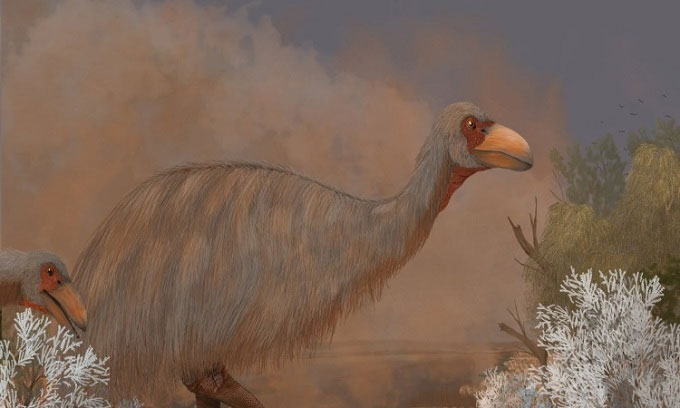The fossil of a thunderbird weighing 230 kg and standing two meters tall may have gone extinct due to prolonged drought and osteomyelitis.
Researchers at Flinders University have uncovered the causes leading to the extinction of the giant thunderbird of Australia, Genyornis newtoni. The clues came from the discovery of a rare series of fossils. The team’s findings reveal severe bone infection in several thunderbird fossils excavated from the 160 km2 Callabonna Lake, located 600 km northeast of Adelaide.

Reconstruction of the ancient thunderbird. (Photo: Phoebe McInerney)
Weighing 230 kg, Genyornis is about 5 to 6 times heavier than an emu and stands two meters tall, but this massive bird not only got stuck in the mud of the lake but also seemed to face a painful disease. According to lead researcher Phoebe McInerney, this could hinder their ability to move and forage.
“The fossils showing signs of infection were primarily concentrated in the chest, thigh, and feet of four individuals. They became increasingly weak, suffering from pain that made it difficult for them to find water and food. Finding a well-preserved fossil with signs of infection is extremely rare, let alone several fossils at once. Now, we can better understand the challenges faced by the thunderbirds,” McInerney stated.
The study found that about 11% of the thunderbirds had osteomyelitis. McInerney and colleagues observed that the bones were hollow and deformed, with abnormal growths and cavities in the fossils. The presence of osteomyelitis in many individuals of the population indicates a complex situation leading to this phenomenon.
Associate Professor Lee Arnold, a co-author of the study, dated the salt lake sediments where Genyornis was found, linking them to a period of severe drought that began around 48,000 years ago. At that time, the thunderbird and many other large animals, including ancient relatives of the marsupial bear and kangaroo, faced significant environmental challenges. As the continent dried up, inland lakes and forests began to disappear. Central Australia turned into flat desert. With increasingly harsh conditions, Associate Professor Trevor Worthy suggested that food sources may have diminished, putting considerable pressure on the species.
The research team noted that the impacts of the severe drought included a high rate of bone infections. Individuals weakened by disease were more likely to get stuck in deep mud and die. With no evidence showing that Genyornis survived this period, it is possible that prolonged drought and high disease rates contributed to the extinction of this bird. McInerney and colleagues published their findings in the journal Papers in Palaeontology.


















































